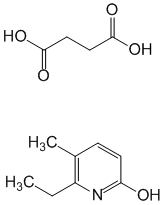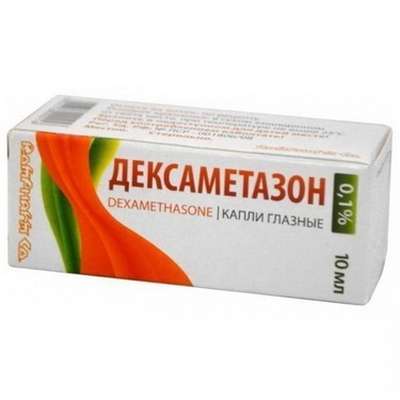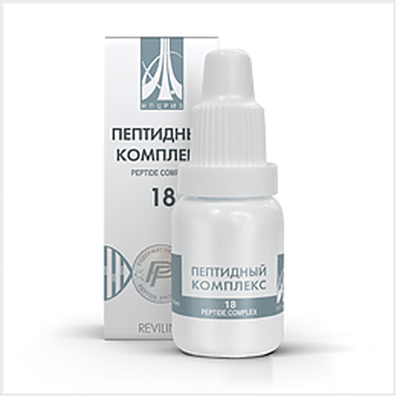Ethylmethylhydroxypyridine succinate - Active Substances. Instruction and Application, Dosage
26 Dec 2016
Name: Ethylmethylhydroxypyridine succinate
The Latin name of the substance Ethylmethylhydroxypyridine succinate
Aethylmethylhydroxypyridini succinas (genus Aethylmethylhydroxypyridini succinatis)
Chemical name: 2-Ethyl-6-methyl-3-hydroxypyridine succinate
Formula - C12H17NO5

Therapeutic substances Ethylmethylhydroxypyridine succinate- Antihypoxants and antioxidants
The nosological classification (ICD-10)
F10.3 abstinence
F40.0 Agoraphobia
F90.0 Violation of activity and attention
G24 Dystonia
G93.4 Encephalopathy, unspecified
I63 Cerebral infarction
I67.2 Cerebral atherosclerosis
I69 The effects of cerebrovascular disease
R41.3.0 * Reduced memory
R41.8.0 * Disorders intellectual mnesticheskie
T43.4 Poisoning neuroleptic-derivatives phenothiazine series, butyrophenone and thioxanthene
CAS code - 127464-43-1
Characteristics substance Ethylmethylhydroxypyridine succinate
White or slightly white with a white crystalline powder. Easily soluble in water.
Pharmacology
Mode of action - antioxidant, membrane, nootropic, cerebroprotective, adaptogenic, anxiolytic.
Inhibits lipid peroxidation, increase of antioxidant activity of the system, activates the energy-synthesizing mitochondrial function improves energy metabolism in the cell, it helps to maintain level macroergs, including under hypoxia stress. Activates intracellular protein and nucleic acid synthesis, enzymatic processes Krebs cycle promotes glucose utilization, synthesis and intra-cellular accumulation of ATP. Restores membrane structure and function, it has a modulating effect on the membrane-bound enzymes, ion channels, transport system neurotransmitter, receptor complexes, including Benzodiazepine-GABA, acetylcholine, improves synaptic transmission and interconnection structures of the brain.
Metabolism and improves blood flow to the brain, blood rheology and micro-circulation, immune system function, inhibits platelet aggregation. It has anti-hypoxic, cerebroprotective, anxiolytic, antistress, nootropic (improved memory, attention, mental performance), anti-hypnotic, about alcohol, anticonvulsant and antiparkinsonian Wegetotropona action. It lowers total cholesterol and LDL and causes the regression of atherosclerotic changes in the arteries (lipid-lowering and anti-atherogenic effect). It has anti-ischemic properties: improves blood flow, limiting the area of ischemic damage and stimulate repair processes. It increases the body's resistance to the effects of extreme factors and oxygen-dependent pathological conditions such as shock, stress, sleep deprivation, hypoxia, cerebrovascular accident, brain injury, ischemia, electric shock, physical and mental overload, conflicts, intoxication (ethanol, etc. ).. It slows down the aging process. Antialcoholic effect is the effect sober and motivation weakening and is used for the relief of withdrawal symptoms and the treatment of acute poisoning. Simultaneous treatment with alcohol intoxication is not exacerbated, and prevents it. Decreases resistance to psychotropic drugs and reinforces their action, which makes the ability to reduce therapeutic doses and the likelihood of adverse effects. Radioprotective properties can be used as a prophylactic measure radiation at high degree.
The experimental and clinical placebo-controlled studies have shown high efficiency oksimetiletilpiridina succinate in the treatment of ischemic stroke (100-1000 mg / day / drip), manifesting regression disorders of consciousness and symptoms of vasomotor instability, accelerating the recovery of motor function.
In children, the inclusion of the drug (10 mg / kg / day orally) in the scheme of therapy of non-paroxysmal supraventricular tachycardia and sick sinus syndrome, increased treatment efficiency on average by 20-27%.
Application of the substance Ethylmethylhydroxypyridine succinate
Injection: acute and chronic cerebral circulatory disorders, including ischemic stroke and its consequences; encephalopathy, dystonia; psychosomatic diseases; neurosis and neurotic disorders with anxiety manifestation of fear, emotional stress; disorders of memory and attention, disturbance of mental capacity; mental and neurological diseases in the elderly, cerebral atherosclerosis; relief of alcohol withdrawal syndrome, accompanied by neurosis and vegetative-vascular disorders; acute intoxication antipsychotics; acute purulent inflammation of the abdominal cavity: acute necrotizing pancreatitis, peritonitis (in the complex therapy).
Tablets: ischemic heart disease (complex therapy).
Contraindications
Hypersensitivity to the hydroxymethyl-ethylpyridine succinate and / or pyridoxine, acute human liver and kidneys, pregnancy, breast-feeding.
Restrictions of application of Ethylmethylhydroxypyridine succinate
Children under 18 years of age (safety and efficacy have not been determined).
Pregnancy and breast-feeding
Contraindicated (adequate clinical experience in pregnancy and during breast-feeding is not).
Side effects of Ethylmethylhydroxypyridine succinate substance
Nausea, dry mouth, allergic reactions.
Interaction
Enhances the effects of alcohol and CNS depressants (opioids, anesthetic, hypnotics, antipsychotics with sedating effect), muscle relaxants, and others. Antacids delay absorption (but do not reduce the extent of absorption) chlordiazepoxide. Chlordiazepoxide may weaken the effect of levodopa. Cimetidine, estrogen oral contraceptives, disulfiram and erythromycin chlordiazepoxide slow metabolism in the liver, increase in blood concentration and delayed excretion. Smoking can weaken the effect of chlordiazepoxide.
Overdose of Ethylmethylhydroxypyridine succinate
In case of overdose possible drowsiness.
Dosing and Administration of Ethylmethylhydroxypyridine succinate
Parenteral: in / m or / in (bolus or infusion).
In / jet (within 5-7 minutes) or a drip (40-60 drops per minute) is used as a solvent physiological sodium chloride solution. The dosage regimen is selected individually. The initial dose of 50-100 mg, 1-3 times a day, then gradually increase the dose to produce a therapeutic effect. The maximum dose - 800 mg / day.
Acute cerebrovascular disease: in the complex therapy - / drip 200-300 mg / day during the first 2-4 days, and then in / m to 100 mg 3 times a day. Duration of treatment - 10-14 days.
Encephalopathy (decompensation phase): in / bolus or infusion at 100 mg 2-3 times a day for 14 days, and then continue introduction / m to 100 mg / day for 14 days. Prevention vascular encephalopathy: a / m, 100 mg 2 times a day for 10-14 days.
Mild cognitive impairment in elderly patients, anxiety disorders: i / m, 100-300 mg / day for 14-30 days.
Abstinence syndrome: 100-200 mg / m 2-3 times a day or in / drop 1-2 times per day for 5-7 days.
Acute intoxication antipsychotics: a / c, 50-300 mg / day for 7-14 days.
Acute necrotizing pancreatitis, peritonitis: used in the pre- and postoperative period, the dosage regimen depends on the process prevalence, severity of the condition.
Inside: 0.1 g 3 times a day. Course Length - not less than two months. Repeated courses - on doctor's advice.
Precautions substance Ethylmethylhydroxypyridine succinate
Be wary of during the drivers of vehicles and people skills relate to the high concentration of attention.
Trading names of drugs with Ethylmethylhydroxypyridine succinate working substance
Trade Name Index
2-ethyl-6-methyl-3-hydroxypyridine succinate, 3-hydroxy-6-methyl-2-ethylpyridine succinate, Astrox, Medomexi, Mexidant, Mexidol, Mexidol solution for injection 5%, Mexicor, Mexipridol, Mexiprim, Mexifin, Metostabil, Neurox, TCerekard, Emoxypine

 Cart
Cart





